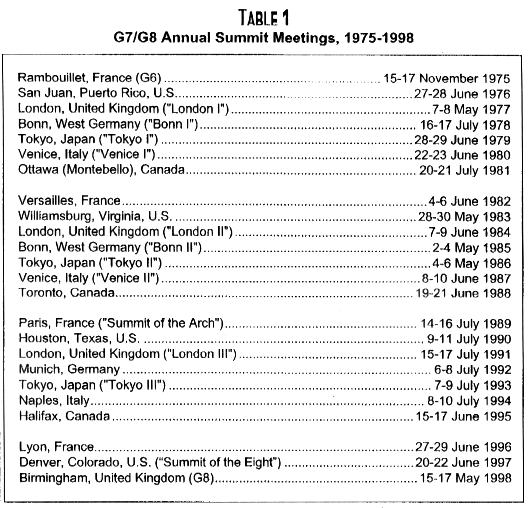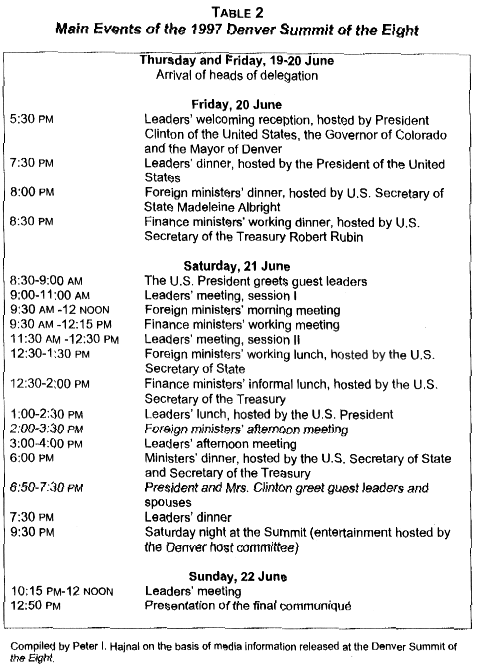|
|
|
|
From G7 To G8:
Evolution, Role and Documentation of a Unique Institution
Peter I. Hajnal
Columbia International Affairs Online
April 1998
The Summit Meetings
The first summit was held in Rambouillet, France, on 15-17 November 1975. The participants were the Five (France, the United States, the United Kingdom, Germany, and Japan) plus Italy. The Rambouillet meeting was originally intended by some of the participants--and presented by all of them--as a one-tnne get-together of the leaders, but U.S. President Ford decided to call another such conference the following year. That meeting, with Canada joining for the first time, met in San Juan, Puerto Rico, from 27 to 28 June 1976. With San Juan, the summit became a regular annual event, taking place in strictly determined rotation among the G7 countries: France, U.S., United Kingdom, Germany, Japan, Italy, Canada. The 1977 London Summit saw the European Community become a participant (then and still a less-than equal one). Table 1 shows the places and dates of the twenty-four annual summit meetings from 1975 to 1998.

In addition to the annual summits, there have been two intersessional summit meetings: in 1985 and 1996. The 1985 special G6 summit took place in New York, without France. U.S. President Ronald Reagan used the occasion to discuss arms-control proposals in preparation for the first U.S.-USSR superpower summit. 15 The 1991 London Summit held out the possibility of convening an extraordinary summit meeting later that year, if necessary, to boost the chances of a successful conclusion of the Uruguay Round. That extraordinary summit was not called even though the Uruguay Round failed to be concluded by the end of 1991.
A special Nuclear Safety and Security Summit was held in Moscow from 19 to 20 April 1996, at the P8 (G8) level; that is, with the full participation of Russia. Discussion focused on the safety of civilian nuclear reactors, the question of nuclear liability, energysector strategies in countries in transition to a market economy, nuclear-waste management, the security of nuclear material and the prevention of illicit trafficking in nuclear material, the control and physical protection of--and accounting for--nuclear material, and the safe and effective management of weapons-grade fissile material designated as no longer required for defense purposes.
The special summit held by the United States, Germany, the United Kingdom and France in Guadeloupe on 5-6 January 1979 was not part of the regular G7 cycle but rather a legacy of past Atlanticism. The four participants discussed missiles in Europe and arms-control negotiations with the USSR, as well as the situation in Iran. 16 Members Japan, Italy and Canada, as well as some other countries, resented not being invited. The Guadeloupe meeting gave those three "a strong incentive to develop the economic summit as a more formal and visible vehicle for political discussions, going beyond spontaneous exchanges over meals. This would ensure that they would not be excluded from high-level political decisions in future." 17
Table 2 summarizes the main events of the 1997 Denver Summit of the Eight, showing how much Russia's role had changed. In Denver, the Russians participated from the beginning of the summit but with time set aside for the G7 to consider financial and other economic questions. This contrasts with the 1994 Naples Summit, the 1995 Halifax Summit and the 1996 Lyon Summit, each of which had two quite distinct phases: these summits were G7 events up to and including the release of the communique' but then became the P8 for the rest of the summit.

Notes:
Note 15: Kirton, "The Diplomacy of Concert: Canada, the G7 and the Halifax Summit," 66. Back.
Note 16: Valery Giscard d'Estaing, Le pouvoir et la vie (Power and Life) ( [s.l. :] Compagnie 12, 1988): 109-11. Back.
Note 17: Putnam and Bayne, Hanging Together: Cooperation and Conflict in the Seven-Power Summits, rev. ed., 105. Back.